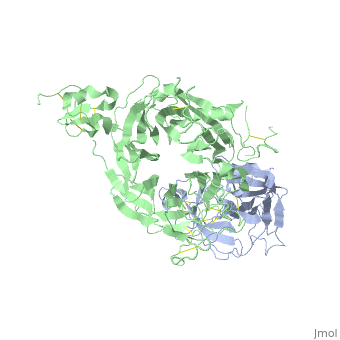1shy: Difference between revisions
No edit summary |
No edit summary |
||
| (5 intermediate revisions by the same user not shown) | |||
| Line 1: | Line 1: | ||
== | ==The Crystal Structure of HGF beta-chain in Complex with the Sema Domain of the Met Receptor.== | ||
[[ | <StructureSection load='1shy' size='340' side='right'caption='[[1shy]], [[Resolution|resolution]] 3.22Å' scene=''> | ||
== Structural highlights == | |||
==Function== | <table><tr><td colspan='2'>[[1shy]] is a 2 chain structure with sequence from [https://en.wikipedia.org/wiki/Homo_sapiens Homo sapiens]. Full crystallographic information is available from [http://oca.weizmann.ac.il/oca-bin/ocashort?id=1SHY OCA]. For a <b>guided tour on the structure components</b> use [https://proteopedia.org/fgij/fg.htm?mol=1SHY FirstGlance]. <br> | ||
[ | </td></tr><tr id='method'><td class="sblockLbl"><b>[[Empirical_models|Method:]]</b></td><td class="sblockDat" id="methodDat">X-ray diffraction, [[Resolution|Resolution]] 3.22Å</td></tr> | ||
<tr id='resources'><td class="sblockLbl"><b>Resources:</b></td><td class="sblockDat"><span class='plainlinks'>[https://proteopedia.org/fgij/fg.htm?mol=1shy FirstGlance], [http://oca.weizmann.ac.il/oca-bin/ocaids?id=1shy OCA], [https://pdbe.org/1shy PDBe], [https://www.rcsb.org/pdb/explore.do?structureId=1shy RCSB], [https://www.ebi.ac.uk/pdbsum/1shy PDBsum], [https://prosat.h-its.org/prosat/prosatexe?pdbcode=1shy ProSAT]</span></td></tr> | |||
</table> | |||
== Disease == | |||
[https://www.uniprot.org/uniprot/HGF_HUMAN HGF_HUMAN] Defects in HGF are the cause of deafness autosomal recessive type 39 (DFNB39) [MIM:[https://omim.org/entry/608265 608265]. A form of profound prelingual sensorineural hearing loss. Sensorineural deafness results from damage to the neural receptors of the inner ear, the nerve pathways to the brain, or the area of the brain that receives sound information.<ref>PMID:19576567</ref> | |||
== Function == | |||
[https://www.uniprot.org/uniprot/HGF_HUMAN HGF_HUMAN] Potent mitogen for mature parenchymal hepatocyte cells, seems to be a hepatotrophic factor, and acts as a growth factor for a broad spectrum of tissues and cell types. Activating ligand for the receptor tyrosine kinase MET by binding to it and promoting its dimerization.<ref>PMID:15167892</ref> <ref>PMID:20624990</ref> | |||
== Evolutionary Conservation == | |||
[[Image:Consurf_key_small.gif|200px|right]] | |||
Check<jmol> | |||
<jmolCheckbox> | |||
<scriptWhenChecked>; select protein; define ~consurf_to_do selected; consurf_initial_scene = true; script "/wiki/ConSurf/sh/1shy_consurf.spt"</scriptWhenChecked> | |||
<scriptWhenUnchecked>script /wiki/extensions/Proteopedia/spt/initialview01.spt</scriptWhenUnchecked> | |||
<text>to colour the structure by Evolutionary Conservation</text> | |||
</jmolCheckbox> | |||
</jmol>, as determined by [http://consurfdb.tau.ac.il/ ConSurfDB]. You may read the [[Conservation%2C_Evolutionary|explanation]] of the method and the full data available from [http://bental.tau.ac.il/new_ConSurfDB/main_output.php?pdb_ID=1shy ConSurf]. | |||
<div style="clear:both"></div> | |||
==See Also== | ==See Also== | ||
*[[Hepatocyte growth factor receptor|Hepatocyte growth factor receptor]] | *[[Hepatocyte growth factor|Hepatocyte growth factor]] | ||
*[[Hepatocyte growth factor receptor 3D structures|Hepatocyte growth factor receptor 3D structures]] | |||
== | == References == | ||
<references/> | |||
__TOC__ | |||
</StructureSection> | |||
[[Category: Homo sapiens]] | [[Category: Homo sapiens]] | ||
[[Category: | [[Category: Large Structures]] | ||
[[Category: | [[Category: Stamos J]] | ||
[[Category: | [[Category: Wiesmann C]] | ||
Latest revision as of 09:14, 3 April 2024
The Crystal Structure of HGF beta-chain in Complex with the Sema Domain of the Met Receptor.The Crystal Structure of HGF beta-chain in Complex with the Sema Domain of the Met Receptor.
Structural highlights
DiseaseHGF_HUMAN Defects in HGF are the cause of deafness autosomal recessive type 39 (DFNB39) [MIM:608265. A form of profound prelingual sensorineural hearing loss. Sensorineural deafness results from damage to the neural receptors of the inner ear, the nerve pathways to the brain, or the area of the brain that receives sound information.[1] FunctionHGF_HUMAN Potent mitogen for mature parenchymal hepatocyte cells, seems to be a hepatotrophic factor, and acts as a growth factor for a broad spectrum of tissues and cell types. Activating ligand for the receptor tyrosine kinase MET by binding to it and promoting its dimerization.[2] [3] Evolutionary Conservation Check, as determined by ConSurfDB. You may read the explanation of the method and the full data available from ConSurf. See AlsoReferences
|
| ||||||||||||||||
